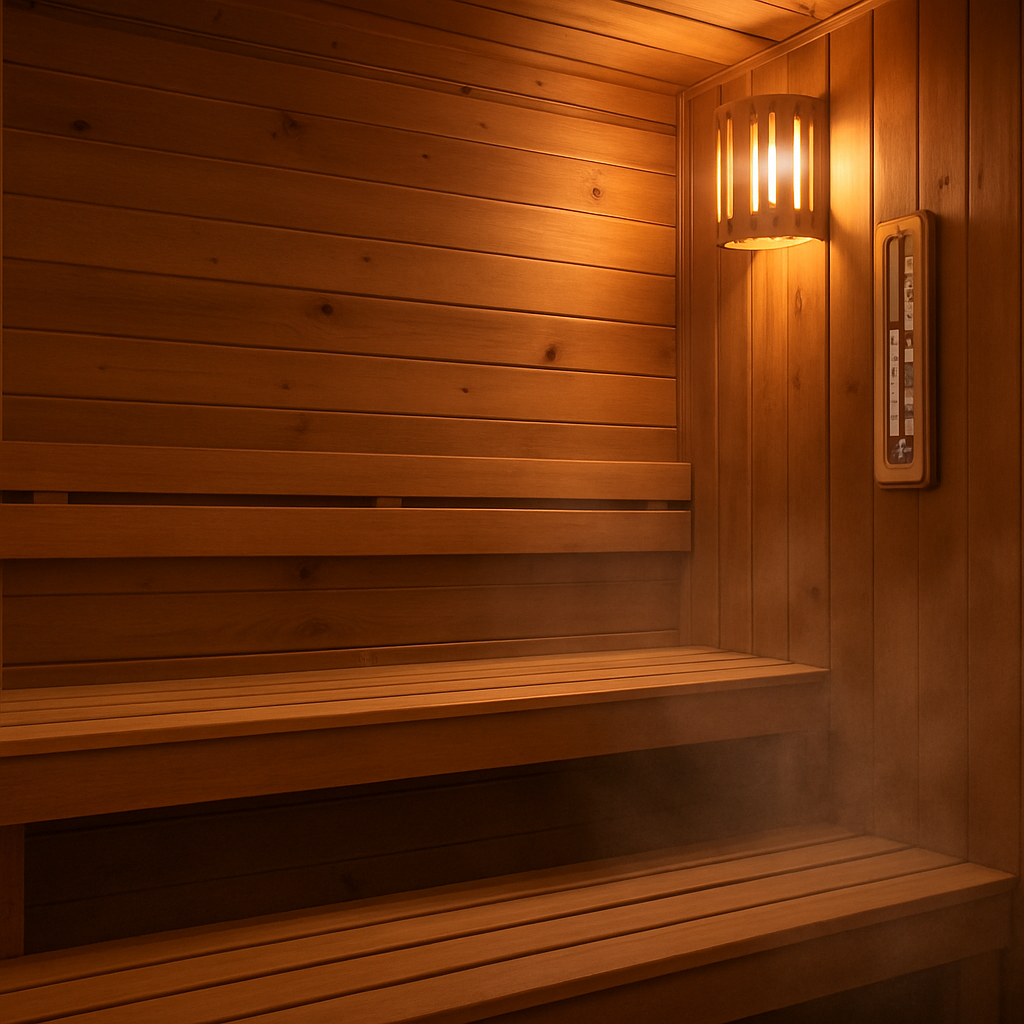
Optimal Sauna Temperature for Relaxation and Health
Finding the ideal sauna setting can transform your experience, offering both relaxation and health benefits. Whether you’re looking to unwind or boost your well-being, the right environment plays a key role. It’s not just about heat; it’s about creating a space that suits your needs.

Different types of saunas, like traditional, infrared, and steam, have unique characteristics. Each one requires adjustments to achieve the best results. Factors such as humidity, session length, and personal tolerance also influence your comfort and safety.
By understanding these elements, you can tailor your experience to maximize relaxation and health benefits. Always prioritize safety to ensure a pleasant and effective session. Let’s explore how to create the perfect setup for your goals.
Key Takeaways
- Personalize your sauna experience based on your goals and sauna type.
- Proper heat levels enhance relaxation and health benefits like stress relief.
- Safety is essential for a comfortable and enjoyable session.
- Traditional, infrared, and steam saunas have distinct temperature needs.
- Consider factors like humidity, duration, and personal tolerance for the best results.
Understanding Sauna Temperature: A Comprehensive Guide
Heat and humidity work together to create the perfect experience. Whether you’re in a traditional setup or an infrared one, the interaction between these elements shapes your comfort. It’s not just about how warm the air feels—it’s about how your body responds to it.
In traditional setups, the air is heated to high levels, often between 70-90°C. Infrared options, on the other hand, focus on warming your body directly, typically ranging from 38-65°C. Each method has its own unique way of delivering relaxation and health benefits.
What is Sauna Temperature?
It’s the combination of air warmth and humidity that defines the environment. In steam rooms, humidity is at 100%, making the heat feel more intense. Traditional setups, however, maintain humidity levels between 5-15%, offering a different kind of experience.
The "Rule of 200" is a helpful guideline for steam rooms. Here, the sum of the heat and humidity should equal 200. For example, if the heat is 50°C, the humidity should be 150%. This balance ensures a comfortable and effective session.
Why Temperature Matters in a Sauna
Your body’s position also plays a role. Sitting on upper benches exposes you to more warmth, while lower benches are cooler. This allows you to adjust your experience based on your comfort level.
Proper heat control isn’t just about comfort—it’s about safety and therapeutic outcomes. By understanding these factors, you can create an environment that maximizes relaxation and health benefits.
Types of Saunas and Their Temperature Ranges
Exploring the variety of setups can help you find the perfect fit for your relaxation needs. Each type offers unique benefits, from deep tissue warmth to soothing humidity. Understanding these distinctions ensures a personalized experience tailored to your preferences.
https://www.youtube.com/watch?v=RWkv9ad7zvc
Traditional Finnish Saunas
Traditional Finnish setups are known for their high heat levels, typically ranging from 150-195°F (65-90°C). These designs use dry air with humidity levels between 5-15%, creating a crisp and invigorating environment. Cedar wood is often used for its natural heat retention and aromatic properties.
In Finland, these setups are a cultural staple, often found in homes and public spaces. The high warmth promotes relaxation and detoxification, making it a popular choice for those seeking a classic experience.
Infrared Saunas
Infrared options operate at lower temperatures, usually between 100-140°F (38-60°C). Instead of heating the air, they use infrared light to warm your body directly. This method allows for deep tissue penetration, offering therapeutic benefits without the intense heat.
Modern designs often incorporate materials like carbon or ceramic for efficient heat distribution. These setups are ideal for those who prefer a gentler yet effective approach to relaxation.
Steam Saunas
Steam rooms, also known as steam saunas, maintain warmth levels of 90-120°F (30-50°C) with 100% humidity. Despite the lower temperatures, the high humidity makes the environment feel hotter and more intense. Tile or stone materials are commonly used to retain moisture and heat.
This type is perfect for those who enjoy a steamy, spa-like atmosphere. It’s particularly beneficial for respiratory health and skin hydration.
Ideal Sauna Temperature for Relaxation
The right warmth can make all the difference in achieving a calming experience. Whether you’re a beginner or a seasoned user, finding your comfort zone ensures a session that’s both enjoyable and beneficial. Start at a lower level, around 150°F, and gradually increase as your body adapts.

Finding Your Comfort Zone
Beginners should aim for 150°F to build tolerance over time. Regular users often prefer 175°F for 20-minute sessions, balancing relaxation and safety. This gradual approach, known as hormesis, helps your body adapt to higher warmth levels without discomfort.
How Temperature Affects Relaxation
Lower settings, like 120-140°F, are perfect for extended, meditation-friendly sessions. These levels promote deep breathing and mental clarity. Heat also triggers endorphin release, reducing stress and enhancing relaxation.
In group settings, avoid peer pressure to go beyond your comfort level. Use a thermometer/hygrometer combo for precision, ensuring the environment matches your needs. This approach maximizes both safety and enjoyment.
| Experience Level | Recommended Warmth | Session Duration |
|---|---|---|
| Beginner | 150°F | 10-15 minutes |
| Intermediate | 165°F | 15-20 minutes |
| Advanced | 175°F | 20 minutes |
Health Benefits of the Right Sauna Temperature
Using the right warmth can unlock numerous health benefits. From improving circulation to enhancing mental well-being, the ideal environment supports both physical and emotional wellness. Let’s explore how proper heat levels can transform your experience.
https://www.youtube.com/watch?v=_L04EYo2v94
Improved Circulation
Heat causes blood vessels to expand, a process known as vasodilation. This improves blood flow, which can lower pressure and reduce cardiovascular risks. According to the Mayo Clinic, using a sauna four times weekly can significantly decrease these risks.
Sweating also helps detoxify the body by opening pores and cleansing the skin. This natural process removes impurities, leaving you feeling refreshed and rejuvenated.
Stress Relief and Mental Health
Warmth triggers the release of endorphins, which promote stress relief and relaxation. Studies show that regular use can reduce symptoms of depression and anxiety, offering a natural way to improve mental health.
Infrared options are particularly effective for deep tissue benefits, while traditional setups are better for respiratory health. However, those with asthma or heart conditions should avoid excessive heat to prevent complications.
| Benefit | Effect | Recommended Setup |
|---|---|---|
| Improved Circulation | Lowers blood pressure | Traditional or Infrared |
| Detoxification | Cleanses skin | Steam or Traditional |
| Mental Health | Reduces stress and anxiety | Infrared |
How to Determine Your Optimal Sauna Temperature
Your ideal environment depends on a mix of personal factors and preferences. Finding the best sauna temperature ensures a session that’s both comfortable and beneficial. Whether you’re new to this or a seasoned user, tailoring your experience is key.

Factors to Consider
Start by evaluating your age, health status, and hydration levels. Younger individuals often tolerate higher warmth better, while older adults may prefer gentler settings. If you have health concerns, consult a professional before use.
In group sessions, compromise is essential. For example, kids need lower warmth to stay safe and comfortable. Always prioritize safety and adjust based on everyone’s needs.
Personalizing Your Sauna Experience
Begin with trial sessions at 10°F increments to find your preference. This gradual approach helps your body adapt without discomfort. Avoid alcohol or heavy meals before use to ensure a smooth experience.
Use tiered benches to test heat gradients. Lower benches are cooler, while upper ones provide more warmth. Wearable fitness trackers can help monitor your heart rate and ensure you stay within safe limits.
“The key to a great session is listening to your body and adjusting as needed.”
Here’s a quick checklist to guide you:
- Comfort: Are you relaxed and at ease?
- Sweat Rate: Is your body responding naturally?
- Post-Session Energy: Do you feel refreshed or drained?
By following these steps, you can create a personalized setup that maximizes relaxation and health benefits.
Safety Tips for Sauna Temperature Control
Ensuring a safe and enjoyable experience starts with proper heat management. While the benefits are significant, understanding how to control the environment is key to avoiding risks. Always prioritize your well-being by following these guidelines.
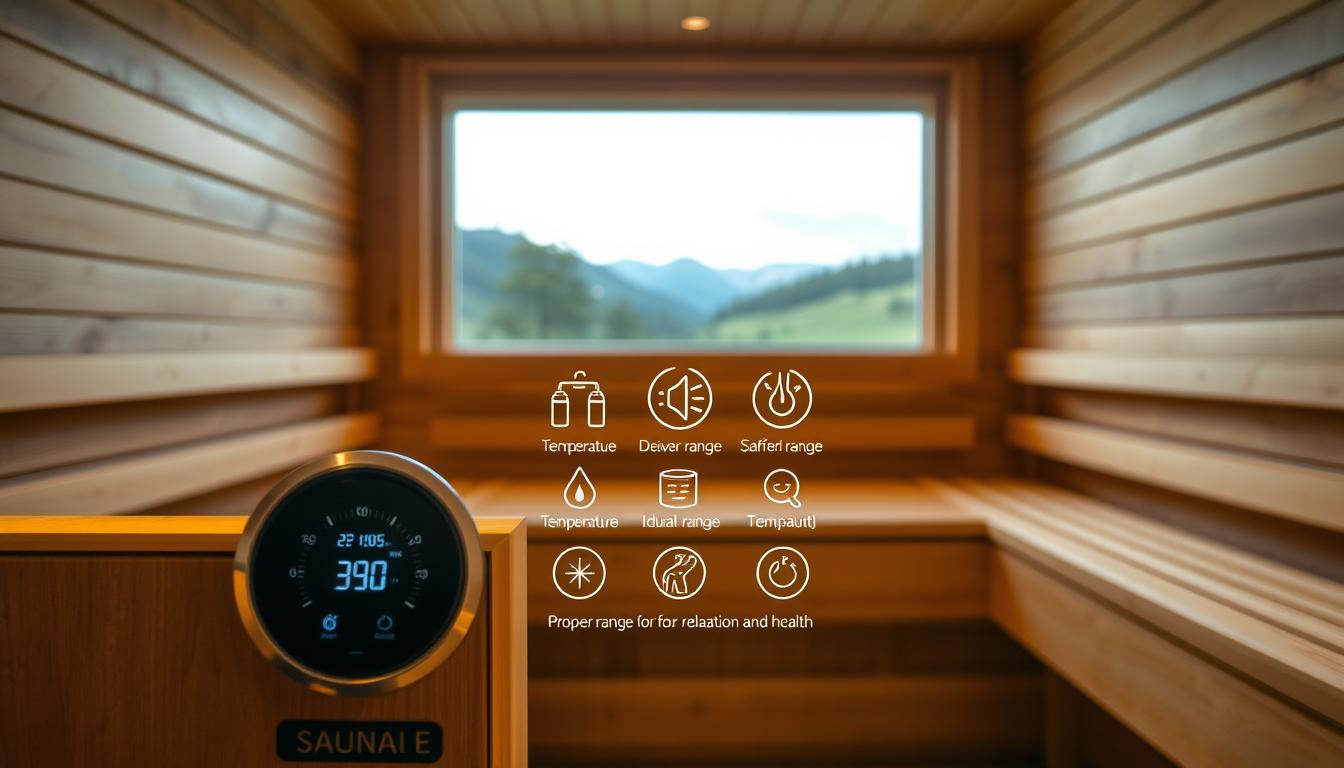
Gradual Temperature Increase
Start with lower temperatures and gradually increase the heat. This allows your body to adapt without stress. For beginners, 150°F is a good starting point. Over time, you can adjust to higher levels as your tolerance improves.
Take 5-minute cooldowns between 15-minute sessions. This prevents overheating and ensures your body stays comfortable. Hydration is also crucial—drink water or electrolyte-rich beverages like coconut water to replenish lost fluids.
Monitoring Your Body’s Response
Pay attention to how your body reacts during the session. Signs like dizziness, nausea, or a rapid heartbeat indicate it’s time to step out. Healthy sweating is normal, but dehydration symptoms like dry mouth or fatigue require immediate attention.
Avoid ice baths if you have circulatory issues. Instead, opt for a cool shower or a gentle cooldown. Remember, safety is about listening to your body and making adjustments as needed.
“A well-managed session maximizes benefits while minimizing risks.”
- Start low and increase heat gradually.
- Take regular breaks to cool down.
- Stay hydrated with water or electrolyte drinks.
- Watch for danger signs like dizziness or nausea.
- Avoid extreme cooling methods if you have health concerns.
Best Practices for Sauna Use
To get the most out of your session, following best practices is essential. Whether you’re a beginner or a regular user, these tips will help you stay safe and maximize the benefits. Let’s dive into the key aspects of hydration, breaks, and session timing.

Hydration and Breaks
Staying hydrated is crucial when using sauna. You can lose up to a pint of sweat per session, so drink 16 oz of water 30 minutes before starting. Afterward, replenish fluids with water or electrolyte-rich drinks like coconut water.
Take breaks between sessions to cool down. A 5-minute cooldown after 15-20 minutes helps your body recover and prevents overheating. This rhythm optimizes benefits while keeping you comfortable.
Duration and Frequency of Sessions
For beginners, start with shorter sessions of 10-15 minutes and gradually increase the time. Regular users often find 20-minute sessions ideal. Three rounds with cold plunges in between are a traditional Nordic approach that enhances circulation and relaxation.
When it comes to frequency, daily use can support detoxification, while weekly sessions are great for maintenance. Avoid using the space right after intense workouts to prevent hypotension.
“The Nordic tradition of using birch whisks during sessions boosts circulation and adds a refreshing touch.”
Here’s a quick checklist to guide your routine:
- Hydrate before and after with water or electrolytes.
- Use a sand timer to track session length.
- Take breaks to cool down and recover.
- Adjust frequency based on your goals—daily for detox or weekly for maintenance.
- Explore traditions like birch whisk use for added benefits.
Maximizing Your Sauna Experience
Enhancing your session with thoughtful activities can elevate both relaxation and recovery. The time after your session is just as important as the time spent inside. By incorporating specific practices, you can amplify the benefits and make the most of your sauna experience.
Post-Sauna Activities
After stepping out, consider a cold shower to boost your metabolic rate. This technique, popularized by the Wim Hof method, helps improve circulation and reduces inflammation. It’s a great way to invigorate your body and enhance the flow of energy.
Aromatherapy can also enhance your post-session routine. Adding a few drops of eucalyptus oil to your shower or diffuser can improve respiratory benefits and leave your skin feeling refreshed. It’s a simple yet effective way to extend the calming effects.
- Take 5-minute mindfulness cooldowns to center your thoughts.
- Try contrast therapy (alternating hot and cold) to reduce muscle soreness.
- Use magnesium spray for faster muscle recovery.
Enhancing Relaxation and Recovery
Social sessions can add a mental bonding element to your routine. Sharing the experience with friends or family fosters connection and makes the time more enjoyable. It’s a great way to combine physical and emotional well-being.
Recovery tools like foam rollers and electrolyte gels can further support your body. Foam rolling helps release muscle tension, while electrolyte gels replenish essential minerals lost during sweating. These small additions can make a big difference in how you feel afterward.
“The key to a great recovery is consistency and mindfulness in your post-session routine.”
| Activity | Benefit |
|---|---|
| Cold Shower | Boosts metabolism and circulation |
| Aromatherapy | Enhances respiratory health and skin freshness |
| Contrast Therapy | Reduces inflammation and muscle soreness |
| Magnesium Spray | Speeds up muscle recovery |
By integrating these practices, you can transform your sauna experience into a holistic wellness ritual. Whether you’re focusing on physical recovery or mental clarity, these tips ensure you get the most out of every session.
Conclusion
Personalizing your setup ensures a rewarding and safe experience. Whether you prefer the ideal sauna warmth of traditional designs or the gentler approach of infrared, finding what works for you is key. Traditional options range from 150-195°F, while infrared stays between 100-140°F for deep tissue benefits.
Experiment gradually to discover your best sauna environment. Start with lower warmth and increase as your body adapts. Always prioritize safety by staying hydrated and listening to your body’s signals.
Proper usage not only enhances relaxation but also supports long-term health. Improved circulation, stress relief, and detoxification are just a few of the benefits you can enjoy.
What’s your preferred routine? Share your experiences in the comments below!
FAQ
What is the ideal heat level for a traditional Finnish sauna?
Traditional Finnish saunas typically operate between 160°F and 195°F. This range provides a balance of warmth and humidity for a relaxing experience.
How does infrared heat differ from traditional saunas?
Infrared saunas use lower heat levels, usually between 120°F and 140°F, to directly warm your body rather than the air around you. This makes it gentler while still offering health benefits.
What are the benefits of steam saunas?
Steam saunas, also known as steam rooms, maintain a high humidity level at around 110°F to 120°F. They are great for skin hydration and respiratory health.
How does heat affect relaxation in a sauna?
The warmth helps relax muscles, reduce tension, and promote a sense of calm. Finding your comfort zone ensures a more enjoyable and soothing session.
What health benefits can I expect from the right heat level?
Proper heat improves blood flow, reduces stress, and supports mental well-being. It also aids in muscle recovery and detoxification.
How do I determine my optimal heat level?
Consider factors like your tolerance, health goals, and the type of sauna you’re using. Start lower and gradually increase to find what feels best for you.
Are there safety tips for managing heat in a sauna?
Yes, always increase warmth gradually and listen to your body. Take breaks if you feel dizzy or uncomfortable, and stay hydrated.
How long should a sauna session last?
Sessions typically last 15 to 20 minutes, but beginners should start with shorter periods. Adjust based on your comfort and experience level.
What should I do after a sauna session?
Cool down gradually, hydrate, and rest. Post-sauna activities like stretching or a cool shower can enhance relaxation and recovery.

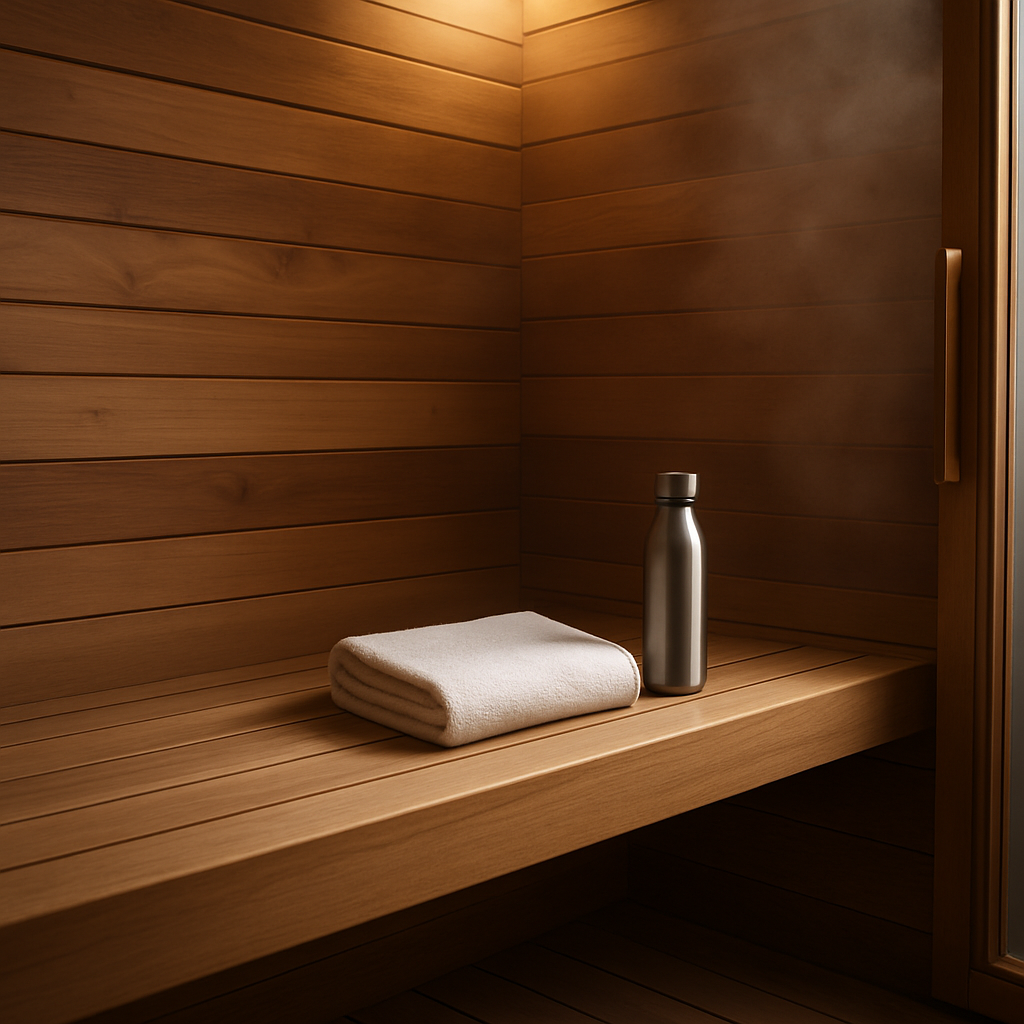
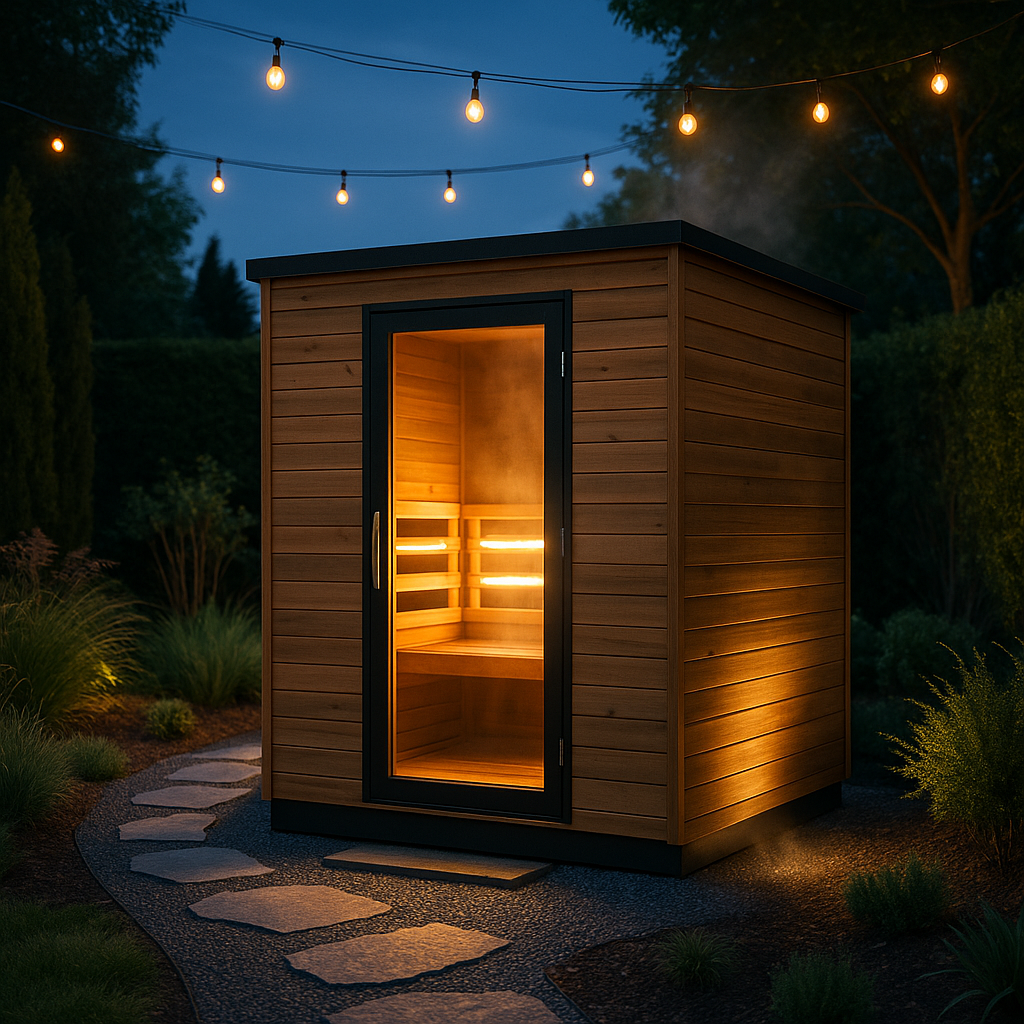

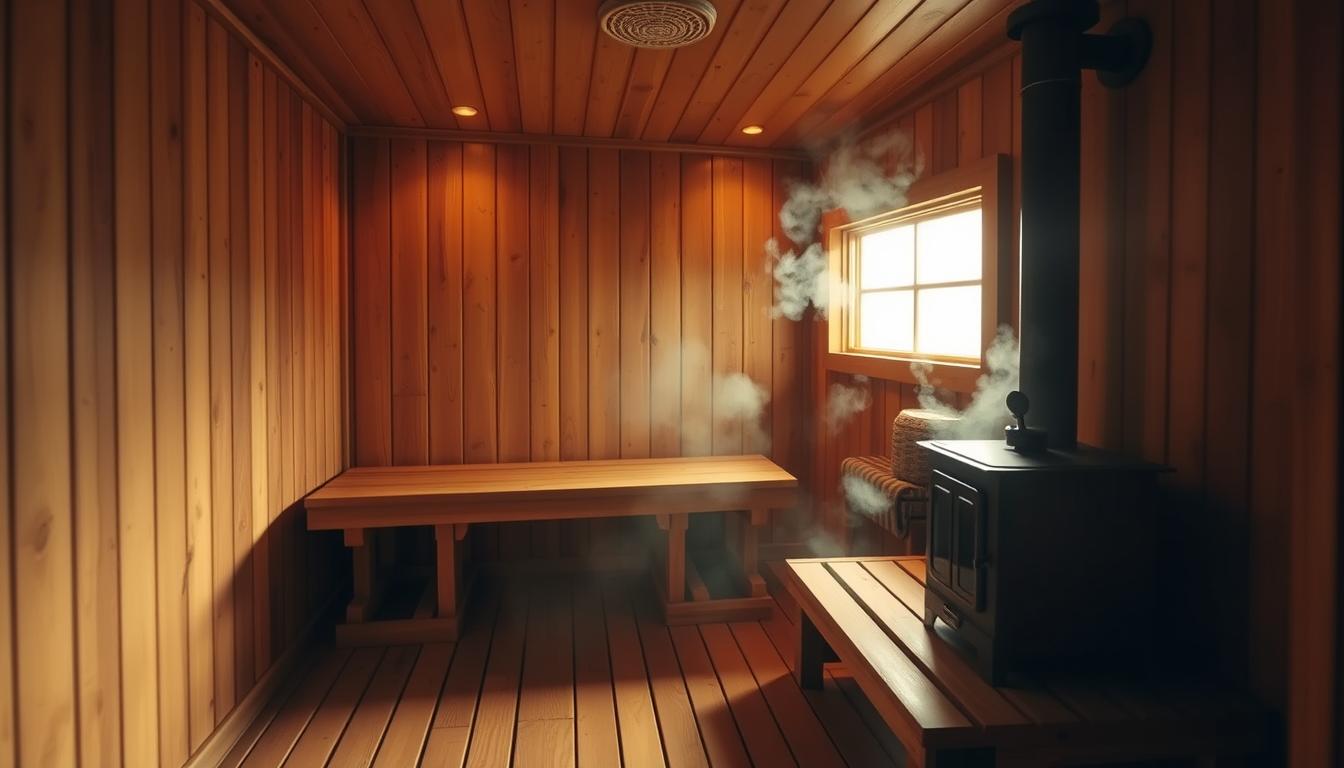


Leave a comment
This site is protected by hCaptcha and the hCaptcha Privacy Policy and Terms of Service apply.